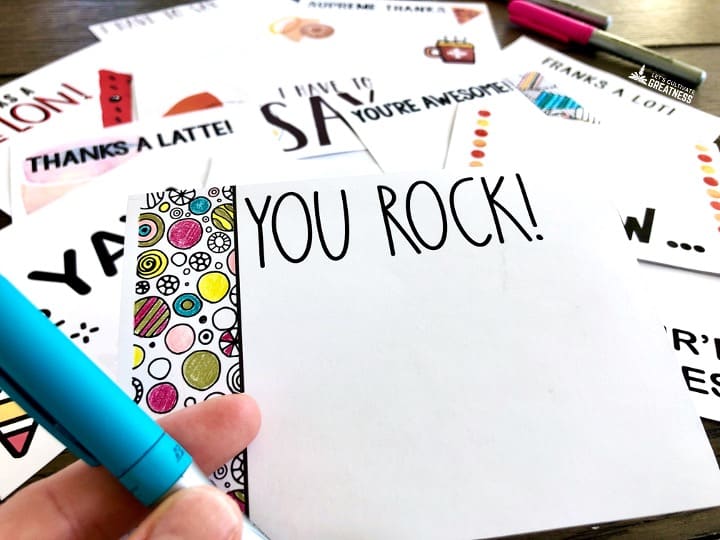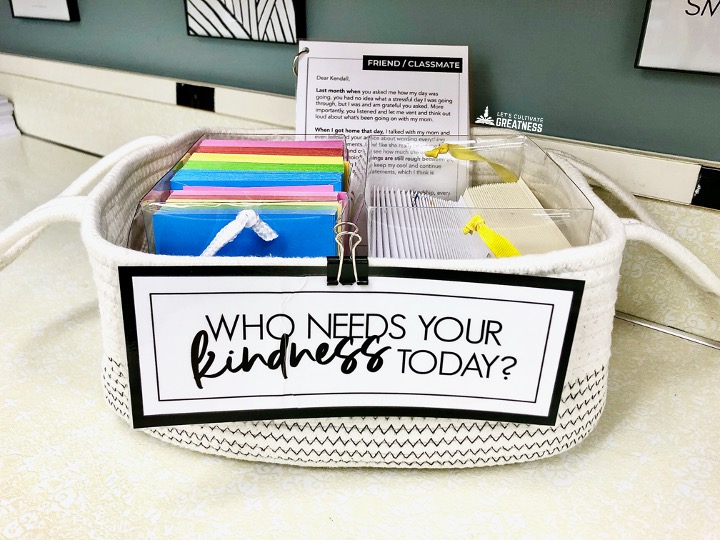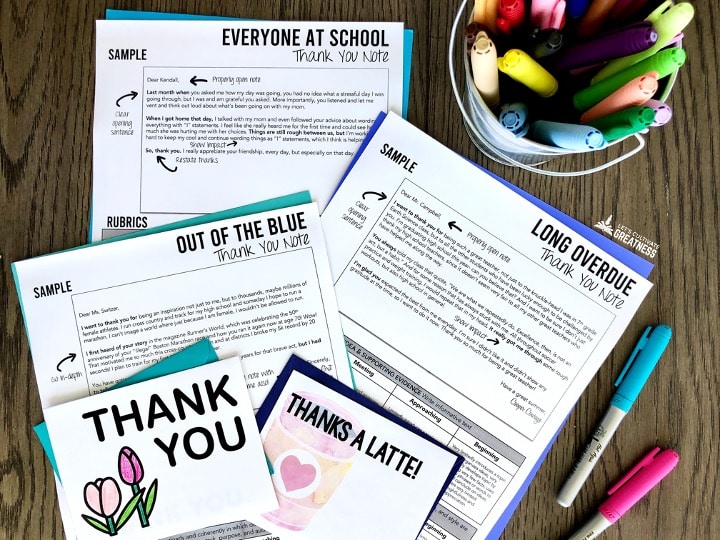It’s never a bad time to teach how to write a heartfelt thank you note. Whether it is for November’s season of gratitude, February’s Random Acts of Kindness Day, or end-of-the-school-year celebrations, there is always a perfect opportunity for it.
And growing up in the age of instant messaging, your students may not realize the weight a handwritten, or at least heartfelt, letter holds. Or how to even write one.
Early in my role as a student council advisor, we picked up the habit of sending thank you cards to everyone: chaperones, volunteers, guest speakers, custodians, parents who donated supplies, and anyone else who helped us out. And I began to notice that the task of writing the thank you cards was one of the first that students signed up to do.
Maybe they thought it was the easiest, or it was a chance for my more artistic students to shine. Regardless, I decided to lean into it and made thank you letter writing one of our defining things.
Soon, we found more ways to incorporate notes of gratitude and kindness throughout the year as their own stand-alone projects, as well as to properly practice the skills of writing thank you notes.
Here are my favorite ones.
Surprise Notes of Kindness
We call this a kindness note flash mob, and we save this project for a time when we have a lull of 3-4 days between planning other events. It also works great to do the week of Thanksgiving, for Random Acts of Kindness Week in February, or as part of an anti-bullying campaign.
Have your school secretary print off the roster of every student in the school. After dividing the number of total students by the kids in your Leadership class or Student Council, challenge each student to that number of notes.
If the ratio is prohibitively high, you may want to widen this project to recruit some school clubs to help or even incorporate this project into one of your classes.
It’s crucial that students select their recipients rather than being assigned them, but equally important is that every single student has been selected. This may mean that some students write a few more than others, but I’ve never encountered that being an issue with my students. The most important thing is that the person writing the note has something specific and kind to say about the recipient.
For this project, we use simple ¼-sheet-sized cards since they’re writing quick, informal notes—like what would be attached to a candy-gram. I stress, though, that just because they are quick doesn’t mean they get to write generic things.

These notes can be a thank you or some sort of note of encouragement or recognition. They just need to be specific—thanking a teammate for a ride home from soccer practice last month or a compliment to a classmate for always having over-the-top costumes on dress-up days.
Once they’re written, determine a method for handing out all the notes on a single day—if possible, directly from the giver to the recipient. You may be able to pull off a single moment, like at lunch, but letting students hand them out as they see classmates throughout the day works, too.
The most important thing is ensuring every single student gets their note within a relatively short amount of time so students don’t feel excluded.
We use this pack of cards. It has over 70 different ¼-sheet design options (plus other sizes!) that work for any season and any type of note.
Thank You Note Mini Lesson
Early in the school year, usually right after Homecoming when we’ve had several staff and parents help us out, I hold a more traditional mini lesson to teach how to properly write a formal, yet personal thank you note. That way every one of my student leaders gets the practice.
First, we make a list of everyone who volunteered their time or donated items to help us put on Homecoming. We even include our vendors like the DJ we hired and school employees like our custodians. The list is usually long enough to assign out a recipient or two to each student.
Then, I show a few sample letters and we review a step-by-step how-to guide for what makes a great thank you letter.
Often, this is the first time a student has ever written a handwritten note of thanks, so it’s such a rewarding lesson to take one class period to do. We also review how to properly address an envelope, since I find many don’t know how to do this either.
There are so many occasions, like after a guest speaker or field trip, or after seniors have gathered all their letters of recommendation for college and scholarships, when a short-yet-formal how-to lesson would be appropriate. You’ll want to decide which event or time of year makes the most sense to set aside time to teach this.
Setting a norm of “here we show our appreciation” creates such a positive school environment and strong reputation with the community, making it a win-win. This short-and-sweet Thank You Note How-To Kit has everything you need for a quick yet impactful lesson.
Thank You Card Basket
After finding a time towards the beginning of the year to formally teach thank you letter writing, create a self-service basket in your classroom for any time kids want to write a thank you note. For mine, I load it with both casual ¼ sheet notes as well as formal folded cards with envelopes as well as copies of how-to directions and example letters. This card kit includes over 150 designs of both sizes and to-go sized handouts for students take with them.

It’s great to have a stash of ready-to-go options for all the cards we write throughout the year, but it’s also so awesome to see students grab one to write on their own.
Hero Thank You Research Project
This project is one I do in my US History class as our Living American Hero project, but it could be done by writing to any sort of person the students don’t personally know.
I have students research a living American whom they admire for their impact and contributions to society, then write and send them an in-depth thank you letter. I love ending the year with this project as a way to recognize how recent so much of our history is. And, because students have already written some informal notes earlier in the year, they are primed to craft these more detailed and heartfelt letters.
Today anyone can direct message or tweet at any celebrity they want at any time, so writing and mailing a letter seems terribly old-fashioned. However, I use this opportunity to encourage students to reflect on how all these micro communications, by nature, aren’t very in-depth or even used for extending thoughtful appreciation, which is why a letter like theirs carries even more weight.
End-of-Year Thank You Notes
This is a no-brainer of an opportunity to teach how to write and encourage your students, especially graduating seniors, to take a moment to write at least one heartfelt note. I have done this in the final days of the year with my seniors and I give them just one rule: the recipient can’t be a teacher, mentor, or coach they’ve had that school year.
Of course, they can write as many as they want (including to people from the current year) and I encourage that, but I want them take a moment to reflect on all the people who have influenced them over their 13 years of school and thank them.
Teaching how to write thank you notes is such privilege because it’s more than just another writing format to practice. It creates a culture of gratitude and recognition among your teen leaders and shows how expressing genuine thanks can make a big impact. If you want an easy way to incorporate several of the project ideas mentioned here, download my 3-part Thank You Note Project Kit that includes directions for everything from casual notes to formal thank you letters.

Feature image credit: Hanny Naibaho








